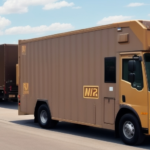Understanding Shipping and Rates for UPS
Shipping plays a pivotal role in the success of businesses, particularly those operating within the e-commerce sector. Among the myriad of shipping carriers, UPS stands out as one of the most trusted and widely used options. However, deciphering UPS shipping rates can be challenging, especially for newcomers. This guide aims to provide a comprehensive overview of UPS shipping rates, factors influencing costs, and strategies to optimize your shipping expenses.
How to Calculate Shipping Rates with UPS
UPS shipping rates are influenced by several key factors, including package weight and dimensions, destination, and chosen shipping speed. To accurately calculate the shipping rate for your package, consider the following:
- Package Weight and Dimensions: Heavier and larger packages generally incur higher shipping costs.
- Destination: Shipping rates vary based on whether the destination is domestic or international.
- Shipping Speed: Faster shipping options, such as expedited or overnight services, are more expensive than standard shipping.
Utilizing the UPS shipping calculator available on the UPS website can simplify this process. This tool considers all relevant factors, including any additional surcharges and fees, to provide an accurate estimate of your shipping costs.
UPS offers a variety of shipping options tailored to different needs:
- Ground Shipping: Cost-effective option for non-urgent deliveries.
- Air Shipping: Quicker delivery times for time-sensitive packages.
- International Shipping: Services catering to shipments across various countries with different delivery speeds.
For instance, if you require expedited delivery, the UPS Next Day Air service ensures your package arrives the next business day.
Beyond calculating shipping rates, UPS provides additional services such as package tracking, delivery confirmation, and insurance options. Leveraging these services ensures your shipments are secure and arrive on time, offering peace of mind throughout the shipping process.
Factors Affecting UPS Shipping Rates
Your UPS shipping rates are influenced by multiple factors:
- Package Weight and Dimensions: UPS bases its rates on the package’s weight and size. Heavier and larger packages typically cost more to ship due to the increased handling and transportation requirements.
- Shipping Speed: Faster shipping options, such as overnight or express services, carry higher costs compared to standard ground shipping.
- Destination: Shipping to remote or international locations can result in higher rates due to additional logistical complexities.
- Item Type: Shipping hazardous materials, fragile items, or goods requiring special handling may incur extra fees. Proper labeling and packaging are essential to comply with UPS regulations and avoid unexpected charges.
Understanding these factors can help you make informed decisions, ensuring cost-effective and efficient shipping.
How to Save Money on UPS Shipping Rates
Optimizing your UPS shipping strategy can lead to significant cost savings. Here are several methods to reduce your UPS shipping expenses:
- Negotiate Rates: If you're a frequent shipper, negotiating better rates with UPS can result in substantial savings.
- Efficient Packaging: Reducing package size and weight by optimizing your packaging can lower shipping costs.
- Compare Shipping Options: Assess different UPS shipping services to find the most cost-effective option that meets your delivery requirements.
- Utilize Discounts and Promotions: Take advantage of UPS's seasonal discounts, loyalty programs, and other promotional offers to reduce costs.
- Use a Shipping Calculator: Estimating shipping costs beforehand using a shipping calculator helps identify the most economical shipping method.
- Third-Party Shipping Services: Consider third-party providers that offer discounted UPS rates, which can further decrease your shipping expenses.
- Industry-Specific Rates: UPS offers special rates for certain industries like healthcare and education. Inquire about available discounts tailored to your sector.
Implementing these strategies can help you manage and reduce your UPS shipping costs effectively.
Different UPS Shipping Options Available
UPS provides a range of shipping options to accommodate diverse needs and budgets. Some of the most popular services include:
- Standard Ground: Reliable and cost-effective for non-urgent deliveries within the U.S.
- 3 Day Select: Guarantees delivery within three business days.
- 2nd Day Air: Ensures delivery by the end of the second business day.
- Next Day Air: Priority shipping for next-business-day delivery.
- Worldwide Express: Fast international shipping with delivery typically within one to three business days.
In addition to these services, UPS offers specialized shipping options for specific industries and goods, such as:
- Healthcare Shipping: Temperature-controlled packaging and transportation for medical supplies and equipment.
- Hazardous Materials Shipping: Compliant handling and transportation for dangerous goods.
These specialized services ensure that businesses can safely and efficiently ship their products, regardless of industry-specific requirements.
Understanding UPS Domestic and International Shipping Policies
Before utilizing UPS services, it's essential to familiarize yourself with their domestic and international shipping policies. These policies outline guidelines on:
- Package Weight and Size Limits: UPS imposes specific weight and size restrictions to ensure safe and efficient handling.
- Packaging Requirements: Proper packaging is crucial to protect goods and comply with UPS standards.
- Customs and Import Procedures: International shipments must adhere to customs regulations, including accurate documentation and appropriate duty payments.
- Shipping Rates: Understanding how rates are calculated helps in budgeting and selecting the right shipping service.
For domestic shipments within the U.S., UPS offers services like UPS Ground, UPS 2nd Day Air, UPS Next Day Air, and UPS 3 Day Select. International services include UPS Worldwide Express, UPS Worldwide Saver, and UPS Worldwide Expedited. Each service varies in delivery times and pricing, allowing you to choose the option that aligns with your timeline and budget.
UPS also provides tracking information for all shipments, enabling you to monitor your package's progress and estimated delivery date effectively.
UPS Shipping Insurance: What You Need to Know
Protecting your shipments against loss or damage during transit is crucial. UPS offers shipping insurance, which covers the value of your package in case of unforeseen events. Key considerations include:
- Cost: The insurance cost is typically a percentage of the item's declared value.
- Coverage: UPS shipping insurance covers the item's value but does not include additional costs like shipping fees or taxes.
- Proof of Value: UPS may require documentation, such as a receipt or appraisal, to process a claim for lost or damaged items.
You can purchase UPS shipping insurance when preparing your shipment through the UPS website or by contacting customer service. Alternatively, third-party shipping insurance providers offer additional options, but it's essential to review their terms and conditions thoroughly before purchasing.
How to Track Your UPS Shipment in Real-Time
One of UPS's standout features is its robust tracking system, allowing you to monitor your shipment in real-time:
- UPS Website and Mobile App: Enter your tracking number to view the current status and estimated delivery time of your package.
- Tracking and Delivery Alerts: Receive notifications about key milestones in your shipment's journey.
- Customized Tracking Preferences: Choose to receive updates via email, text message, or push notifications through the UPS mobile app.
- UPS My Choice: Manage multiple shipments from one dashboard, modify delivery preferences, and update delivery addresses or time windows.
These tracking capabilities enhance transparency and allow you to stay informed about your shipment's progress without repeatedly checking the UPS platform.
Tips for Packing and Labeling Your Packages for UPS Shipping
Proper packing and labeling are essential to ensure your packages are delivered safely and on time. Follow these best practices when preparing your shipments with UPS:
- Protect Your Items: Use adequate cushioning materials like bubble wrap or packing peanuts to safeguard your items from damage during transit.
- Use UPS-Approved Packaging: Ensure compliance with UPS packaging standards by using appropriate materials and packaging methods.
- Accurate Labeling: Clearly label all packages with the correct shipping and return addresses. Include any necessary shipping documents as required.
- Adhere to Weight and Size Limits: Measure and weigh your packages accurately to avoid exceeding UPS's weight and size restrictions, which can lead to additional fees or shipment refusals.
- Secure Sealing: Use high-quality packing tape to seal all edges and seams of your package securely. For added security, consider tamper-evident tape or seals.
Implementing these packing and labeling tips helps prevent shipping delays, reduces the risk of damage, and ensures compliance with UPS’s shipping policies.
Common Mistakes to Avoid When Using UPS for Shipping
Avoiding common pitfalls can enhance your UPS shipping experience and prevent unnecessary costs or delays. Key mistakes to watch out for include:
- Incorrect Package Weight and Dimensions: Ensure accurate measurement and weighing of your packages to prevent overbilling or shipment rejection.
- Inadequate Packaging: Poorly packed items are more susceptible to damage, which can lead to claims and additional costs.
- Improper Labeling: Mislabeling can cause delivery errors or delays. Double-check all shipping labels for accuracy.
- Failing to Declare Correct Package Value: Accurately declare the value of your items to ensure appropriate insurance coverage and avoid disputes during claims.
- Ignoring UPS Shipping Policies: Familiarize yourself with UPS’s policies to ensure compliance and smooth shipping operations.
By being mindful of these common errors, you can streamline your shipping process and mitigate potential issues.
Understanding Customs and Import Fees with UPS International Shipping
When shipping internationally with UPS, it's important to comprehend the associated customs and import fees, which can vary based on the destination country. Key points to consider include:
- Customs Duties and Taxes: These fees are typically assessed by the destination country and are the responsibility of the recipient.
- Customs Documentation: Accurate and complete documentation is essential to expedite the customs clearance process and avoid delays.
- Import Regulations: Different countries have varying import regulations and restrictions. Ensure your shipment complies with these regulations to prevent confiscation or return of goods.
Understanding these factors helps you anticipate additional costs and ensures a smoother international shipping experience with UPS.
How to Schedule Pickup and Delivery with UPS
UPS offers a variety of convenient pickup and delivery options to accommodate both businesses and individual shippers:
- Online Scheduling: Use the UPS website to schedule pickups at your preferred time and location.
- UPS Mobile App: Schedule pickups on-the-go using the UPS mobile application.
- Phone Reservations: Contact UPS customer service to arrange pickups over the phone.
- Drop-Off Locations: Utilize the extensive network of UPS drop-off points for self-service shipping needs.
These flexible options ensure that your shipping needs are met efficiently, whether you’re sending a single package or managing bulk shipments.
The Benefits of Using a UPS Account for Business Shipping Needs
Establishing a UPS account offers numerous advantages for businesses with regular shipping requirements:
- Discounted Shipping Rates: Access to exclusive rates based on shipping volume and business needs.
- Streamlined Package Management: Manage all your shipments from a centralized dashboard, simplifying tracking and administration.
- Advanced Shipping Tools: Benefit from tools and resources designed to optimize your shipping processes.
- Personalized Support: Receive dedicated customer support and resources tailored to your business operations.
- Invoicing and Reporting: Utilize detailed invoices and reports to monitor shipping expenses and identify cost-saving opportunities.
By leveraging a UPS account, businesses can enhance their shipping efficiency, reduce costs, and gain better control over their logistics operations.
How to Get the Best Customer Support from UPS for Your Shipments
Effective customer support is essential for resolving shipping issues and ensuring a positive UPS experience. To maximize the benefits of UPS customer support:
- 24/7 Availability: UPS offers round-the-clock customer service through phone, email, and live chat to address your shipping concerns promptly.
- Comprehensive Support for Account Holders: UPS account holders have access to enhanced support resources, including detailed FAQs, user forums, and self-help documentation.
- Responsive Communication: Reach out to UPS customer service for assistance with tracking, billing, shipping issues, and general inquiries.
- Leverage Support Resources: Utilize UPS’s extensive online resources to find answers to common questions and troubleshoot shipping challenges independently.
Accessing and effectively utilizing UPS customer support ensures that any shipping issues are promptly addressed, maintaining the integrity and reliability of your shipping operations.
Conclusion
Choosing UPS for your shipping needs offers a blend of reliability, comprehensive services, and cost-effective solutions for both businesses and individuals. By understanding UPS’s shipping rates, policies, and available services, you can optimize your shipping strategy to save time and money. Whether sending a small domestic package or managing large international shipments, UPS provides the tools and support necessary to facilitate efficient and secure deliveries. Implement the insights and strategies outlined in this guide to enhance your UPS shipping experience and drive your business forward.




















